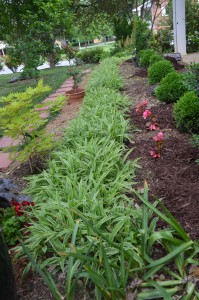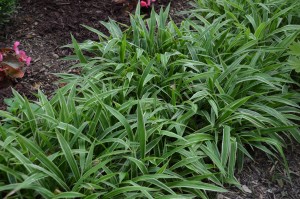The broadleaved sedges (Carex siderosticha) make terrific alternatives to monkey grass (Liriope muscari) (USDA hardiness zones 6-9). This species of sedges is a clump growing perennial and is starting to become more used as a ground cover. Clumps spread very slowly via rhizomes.
Foliage goes dormant in late November (zone 6) and is semi-evergreen in zones 8-9. New leaves emerge in mid-spring. Utilize it as a groundcover in a rock or woodland garden or edge along a partly shaded pathway. Over time plants grow 8-10 inches high and spread to 15 -18 inches wide.
Sedges grow best in moist well-drained soil and prosper in shade or partial shade in moist, compost- rich, well-drained soil. Broadleaved sedges fail in full sun unless frequently irrigated. A new planting should be kept adequately watered until 1-year established. A densely planted bed will crowd out most weeds. Mow off leaf litter in late winter as new shoots begin to emerge in mid- to late-April.
In early spring feed a slow release fertilizer at the low to medium rate. Avoid excess fertilizing as sedges are not salt tolerant. Sedges have very few disease and pest problems, occasionally aphids, spider mites, and leaf spots.
Green flower spikes appear in late spring and have little ornamental significance. Broadleaf sedges tolerate light foot traffic. They mix well with taller growing hostas, astilbes and many flowering annuals.
3 Cultivars To Try:
‘Lemon Zest’ will brighten a woodland garden. It grows 6 inches tall with 6-8 inch long gold colored leaves in spring, then change to chartreuse in summer.
‘Island Brocade’ displays cream-streaked lime green centers and gold edged. It develops into a dense 6-8 inches tall ground cover.
‘Variegata’ – has distinctive broad leaf sedge 1 ¼ inches wide with pointed tips with white margins and narrow striping and bright white border.



 Posted in
Posted in 
